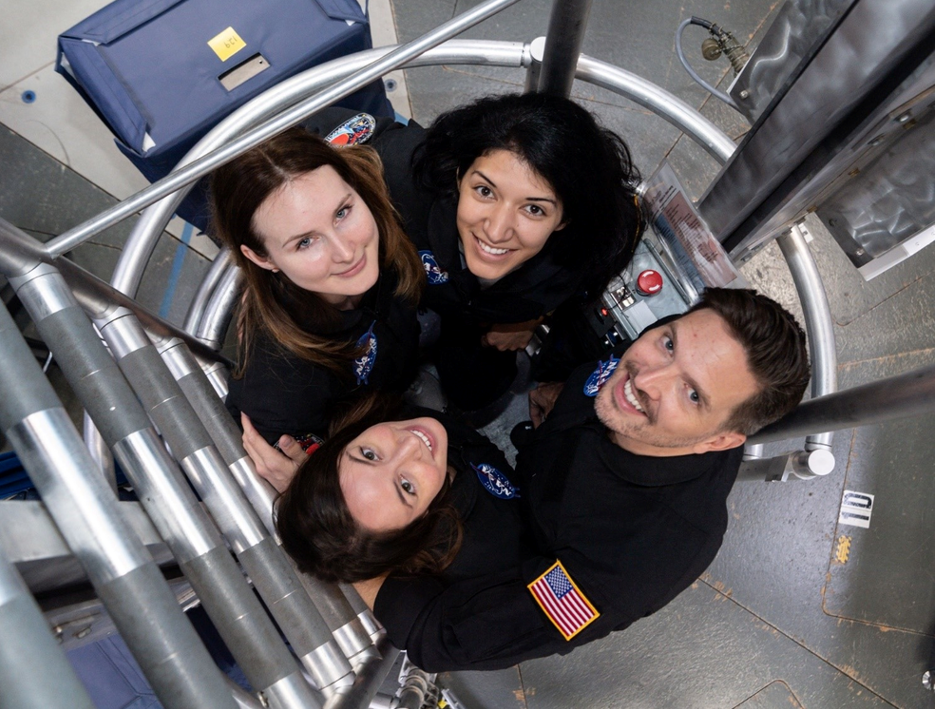Houston, We Have a Groundlink

The crew of NASA's Human Exploration Research Analog Campaign 6 Mission 1 looks up from inside the habitat’s ladder well to say hello. From left to right: (top row) Lauren Cornell and Monique Garcia; (bottom row) Madelyne Willis and Christopher Roberts. Credits: NASA
Want to know what it’s like to go on a mission into deep space without leaving Earth? If you’re a student anywhere around the world, you now can directly ask your questions to crew members on a simulated journey to Mars.
Through a new program called Groundlinks, students can connect with the crew inside NASA’s Human Exploration Research Analog, or HERA. These crew members are on a mission to help scientists learn more about how isolation, confinement, and remote conditions will affect astronauts on Artemis missions to the Moon and on future missions to Mars.
Modeled after Downlinks, which connect media and students with astronauts aboard the International Space Station for a question-and-answer session, the Groundlinks program allows students to interface with the analog crew to learn more about the research NASA is performing on Earth to prepare for future space exploration missions.
As NASA ventures farther into the cosmos, astronauts’ experiences will change. To better anticipate the real-life challenges of deep-space missions, NASA uses Earth-based analogs. These analogs let scientists study how highly motivated people respond under the rigor of mission-critical tasks performed in close quarters, isolated from contact with the outside world.
Through work on HERA, scientists search for insights into a variety of questions. For example: Will the stress of being enclosed, with little contact to the outside world, take a toll on team dynamics? Will that same stress take a toll on crew health? Will virtual assistants and other new technologies created to help astronauts on deep-space missions work with HERA crew as intended?
“Results from these studies will help to inform how NASA plans for future exploration missions, when astronaut crews will need to operate more independently from Earth than they do in current space station missions in low-Earth orbit,” said Brandon Vessey, research operations and integration element scientist for NASA’s Human Research Program, or HRP.
Groundlinks is a partnership between HRP and NASA’s Office of STEM Engagement, or OSTEM.
“It's so important for students to make these kinds of connections with incredible people and role models like the HERA crew members, to learn about their backgrounds and experiences, as they consider their own future paths,” said Kris Brown, NASA's deputy associate administrator for STEM Engagement.
“This project is especially unique in that it encourages students to really think about how to navigate and overcome challenges,” Brown noted. “The crew will be working to learn and address challenges inherent in long-duration spaceflight. These students will enter the STEM workforce during a time when they can impact and make significant contributions to shaping the future of space exploration.”
To submit a question for future Groundlinks with HERA, please email:
To learn more about Groundlinks, watch this video (below).
Watch the first episode of Groundlinks (below).
NASA is leading a return to the Moon for long-term exploration. Through Artemis, NASA will land astronauts, including the first woman and the first person of color, on the surface of the moon. At the moon, NASA and its partners will study and explore more of the lunar surface than ever before. Lessons learned on and around the moon will prepare NASA to take the next giant leap — sending astronauts to Mars.
Learn more about Artemis at:
Mohi Kumar
Shaneequa Vereen
Jennifer L. Turner
NASA Human Research Program Strategic Communications







